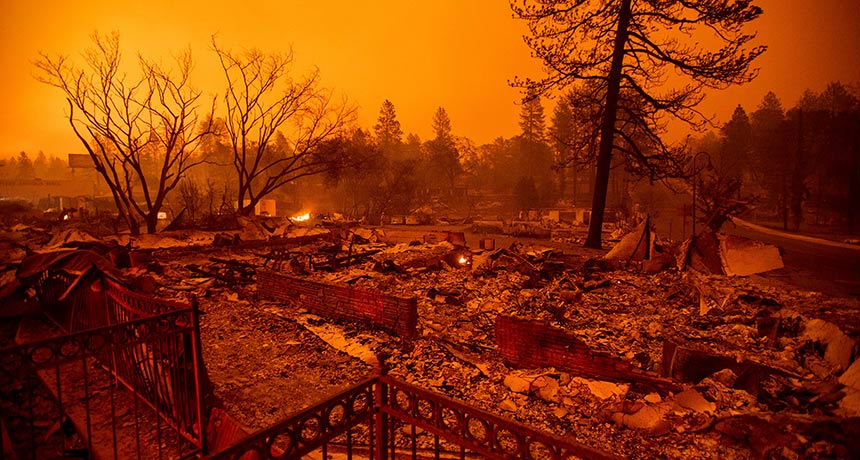
TORCHED TOWN The Camp Fire burned through the town of Paradise in Northern California, leaving behind rubble where houses and businesses once stood.
Noah Berger/Associated Press
- More than 2 years ago
In the past week, the Camp Fire has killed at least 56 people and leveled the Northern California town of Paradise. Another wildfire raging through the Los Angeles suburbs, the Woolsey Fire, has already destroyed more than 500 buildings and forced some 250,000 people to evacuate their homes.
Such disasters are likely to occur more frequently in the coming years, data from recent years suggest. That’s because urban development is creeping further into woodlands, prairies and other natural areas and putting more communities in the path of wildfires. The ongoing California fires have been fueled by drought and high winds, but it’s their proximity to people that has made them especially deadly and destructive — burning through areas where housing abuts grasslands or forests, or where natural vegetation is mixed in with homes.
In California, these “wildland-urban interface areas” expanded almost 20 percent from 1990 to 2010, according to data published in 2017 by the U.S. Forest Service. And the number of homes in that zone increased by almost 34 percent.
Urban expansion into natural areas isn’t unique to California. Nationwide, the wildland-urban interface grew about 33 percent from 1990 to 2010, researchers who worked on the Forest Service dataset reported in March in the Proceedings of the National Academy of Sciences. And other Western states that face frequent wildfires have seen even larger leaps: Colorado’s wildland-urban interface areas expanded by 65 percent, Montana by 67 percent and Idaho by 72 percent, over the same period, the Forest Service found.
Meanwhile, climate change is contributing to more intense droughts and a longer fire season in California and other Western states. The types of wildfires that once occurred every few years are now happening multiple times a year, says Kurt Henke, retired chief of the Sacramento Metropolitan Fire District.
But other Western states “just don’t have the population centers” that California has, Henke says. That new fire regime in a place like California, with lots of people living close to ample fire fuel, is a “recipe for disaster.”
Wildland-urban interface fires are especially hard to manage because there aren’t yet good computer simulations for predicting how they’ll behave, says Volker Radeloff, a landscape ecologist at the University of Wisconsin–Madison who worked on the recent analyses. And dealing with such fires doesn’t fall squarely under the expertise of either wildland firefighters or municipal firefighters. “The wildland-urban interface sort of falls through the cracks. It’s a messy middle — a little wild, but not truly wild.”
As of November 15, the Camp Fire was 35 percent contained, while firefighters had 52 percent of the Woolsey Fire under control. Once the fires are tamed, rebuilding scorched communities can take years.
The problem is likely to get worse as people continue to build homes closer to natural areas, Radeloff says. He and his team calculated urban-interface expansion in each U.S. state using 2010 U.S. census data, and will update their findings once the 2020 census results are released.
California has some of the strictest fire codes in the country, including regulations on new construction in the wildland-urban interface. Buildings must be made of fire-resistant materials, for example, and residents are required to clear brush away from near their houses.
But even housing developments built five years ago may not be able to withstand the severity and frequency of fires in California today, Henke says. “We’re going to have to go back and take another look.”







